A Very Special Re-Homing Story – by Mary Lynn Campbell
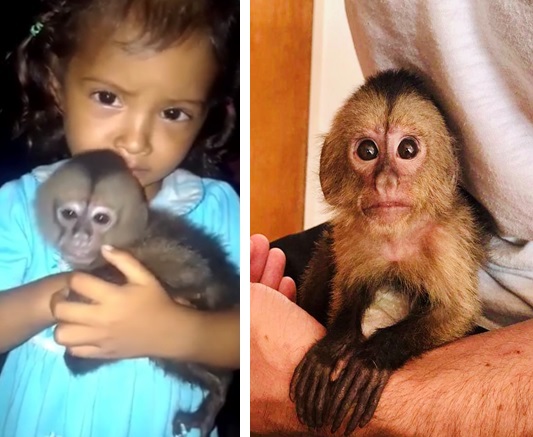
Welcome back to the Primate Care Site. We hope that you and your families have been able to remain healthy during this world pandemic. Although I have not been able to resume taking the monkeys of SunShine MonkeyShines out to local schools and birthday parties, I have been very busy networking with many of you who have needed help with your monkeys. This site has provided me with an ability to network with many monkey families all around the world. I thought it would be a wonderful time to share the story of one of these families unique experience with giving a home to two Capuchin monkeys.
Soon after writing my last post, I was contacted by someone from South America whose family in earlier years had been active in caring many of the smaller primate species. As we all know, in South America their are many different types of primates living on that continent. I hope you will enjoy hearing this story from a part of the world where New World Monkeys are actually born into wild troops.
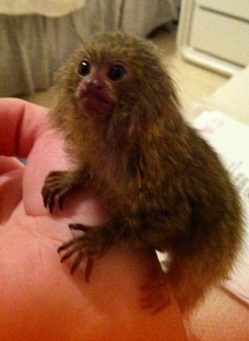
One of the wild Pygmy Marmosets from South America that this family cared for several years ago.
Sometimes as we grow older, we begin thinking that some of our most exciting experiences are behind us, but this was not the case for one particular primate loving family in South America. It has been a wonderful life changing experiences for me also as I became acquainted with this amazing family’s pathway to becoming caregivers of their monkeys
Most of the people who choose to get in touch with me about needing help with a monkey have received them from a breeder, but in this story the monkeys who are taken into their home have actually come from the wild troops that are living in the outskirts of their town.
The story starts first with them receiving one that had come from a veterinarian who had been out on a call and spotted an older baby capuchin monkey tied up to a tree without food or water. When he questioned the family who had given this monkey a home, they told him after they had received the baby monkey, they had decided to give it to their children to care for. After a short conversation with them, they decided to surrendered the monkey to him. He could tell that the little monkey was in great needed of some good food, clean water and some loving care.
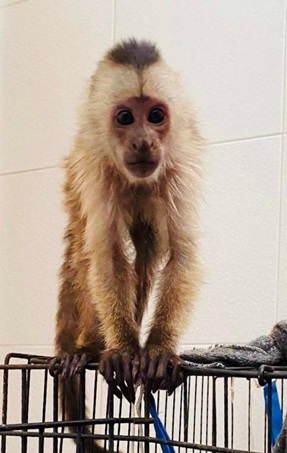
This is the first photo of the little wild-caught monkey who was named Maya. Her age was estimated between 10 and 14 months old.
After the veterinarian arrived back to his office, he decided to call a family who he knew had given homes to several different types of marmosets and tamarins several years ago. He needed someone with actual experience to help give this young, malnourished baby, a chance at a better life so he quickly made the call. Although the family did not know everything about the care of this type of monkey, they decided to do everything that they could do to help the monkey to become a healthy, well adjusted, wild-caught monkey. They named her Maya.
Of course, I made a list of things to talk about with the new caregivers of Maya. It had been many years since I had been the caregiver of a younger wild-caught monkey. As I began thinking about this list, it occurred to me that it was going to be very similar to caring for a newly re-homed breeder monkey:
- The first thing that was discussed was for them to keep a journal of their new Maya’s behavior such as foods that she liked, how much water she drank, and what turned out to be her favorite way to drink her water. They were also asked to keep a log of the things that they decided to try in her cage and how she responded to them.
- The second thing that was discussed was about the tests and things that they needed to discuss with the exotic veterinarian they would need to contact.
- The third thing that was discussed turned out to be a very different thing from what I thought we would be discussing. After a few days of the family becoming caregivers of a young, female, Wedge-Cap, Capuchin monkey, one of the family members was discussing their new journey with helping Maya and suddenly this person started excitedly telling him about being out in a small indigenous village where he saw two tiny baby monkeys who had recently had their mother’s killed by hunters. He knew there was one baby girl and the other baby was a boy. Then he asked the big question, “Would you and your family be willing to try helping these two baby monkey too? Here look, I even have a pictures of a little girl holding one of them. I must go out and remove them from the people in a few days. You can go with me and see them for yourself.”
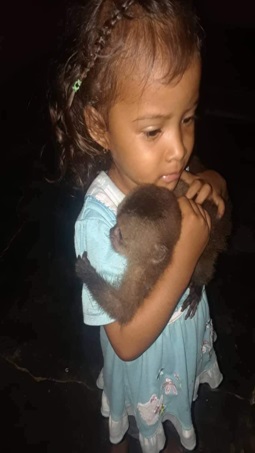
The very first photo of the baby monkey.
So, my list would definitely need to be change because two more baby monkeys were coming to live with them:
- How would Maya respond with there being two baby monkeys added to her new world?
- I suggested that they would need to be kept separate from Maya for health reasons.
- We discussed the differences in caring for the much smaller baby monkeys. They would need formula, tiny pet nursing bottles, preemie or at least newborn diapers, small stuffed toys, small hand toys, a few small blankets, and they would also need to have small crates available for them.
- I knew we needed to talk about one of the most important things and that was not only their physical health but we had to talk about their emotional health. All of the monkeys would be coming to them with having lived through debilitating emotional traumas. It was hard enough to be ripped away from their dead or injured mothers, but they will also have experienced the fear of the troop as they were trying to escape the hunters. These precious baby monkeys would have many different needs from their larger monkey named Maya, and their emotional needs could be very great depending on their condition.
- This list was going to be a one day at a time type of unfolding experience. We all knew that things might unexpectedly change at any given moment, but having three traumatized wild-caught baby monkeys at one time was definitely going to have to be lived one moment at a time.
Two days after hearing about the two baby capuchin monkeys being available to care for, they were called to get ready to go pick them up from the native village.
It was a long drive out into the country where the village was located. When they arrived, they soon found out that the baby girl monkey had passed away but that the boy was still alive. They quickly took the monkey away and started their trip back into the city. Within moments of being with the baby, they knew that he was not in good physical shape. He was lethargic and extremely dehydrated. They could actually feel every single bone within his body and he was so weak with no strength at all. Neither one of them thought that there was a very good chance of the baby boy being able to live.
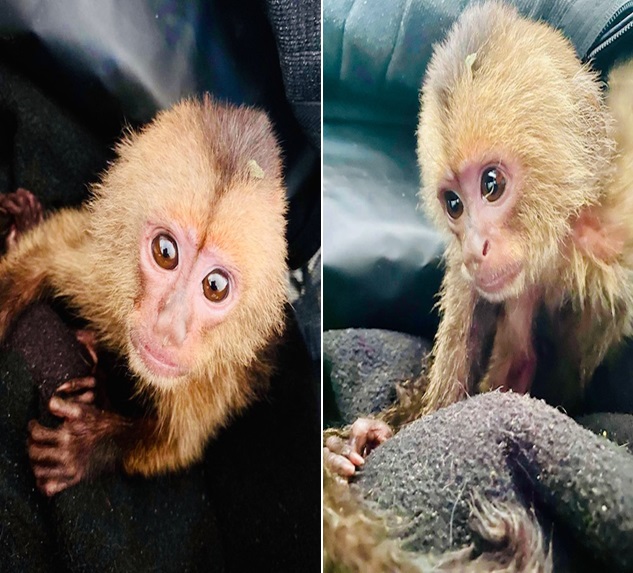
The baby boy weak little legs
Finally, they made it home with the fragile baby boy. He was looked after by their family veterinarian but he felt that the best possible thing to do was to get him started right away on formula, and for him to be kept very warm during the next hours of his life. They all agreed that it would be a hard pathway for the little guy but they were all up for the challenge of helping him to grow in health and well-being.
The little boy monkey would not take any of the fluids that were offered to him for the first day and a half after he arrived. They were frantic about getting nourishment into him so they started trying different nipples on the bottles and then they were able to finally get him into drinking from a tiny pet nursing bottle. He had become even more lethargic by the time they were able to get him to drink his formula. We all felt such relief when he finally began drinking it along with some water, but even though he was drinking now he was still fading. The every two hour feeding schedule was not working to bring him around fast enough so they decided to start giving him formula or water every half hour around the clock. They finally decided to call the little struggling baby boy by the name of Jack. We all knew it was in God’s hands now.
When maya had arrived a few days earlier, she had begun by being very interested in licking small amounts of honey from their hands.
After learning to enjoy this, she began to happily jump into her enclosure after fruits had been placed inside of it. She instantly enjoyed her colorful blankets and hammock. They would add different things to her special place every few days and of course kept trying her on different foods. Within just a few weeks she was starting to happily look forward to having her time out of her enclosure and she was adjusting very well to her new environment. She knew that Jack was in the same house but they had not been able to spend time with each other due to them being kept separately as the vet had also suggested.
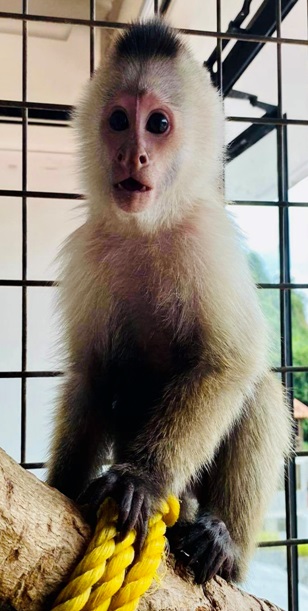
A photo of Maya, a few days after she arrived to the families home.
Maya was improving emotionally and physically, but she was still showing signs of being fearful and unsure of the caregivers being around her enclosure. This was totally expected due to what she had gone through during her life before she had come to live with her new family of humans and animals. She seemed to especially enjoy the stimulation that she received watching the wild birds come to feed in the evening hours. She began to be a typical monkey and enjoy her feeding times especially her monkey chow biscuits. She began showing signs of getting less fearful of hand movement when they would come to spend time with her. We all knew that to her human hands were not to be trusted so everyone that visited with her remembered to approach her slowly with their palms open. It can take a long period of time for a monkey to begin to trust humans but in Maya’s case she slowly starting to trust the members of her new family.
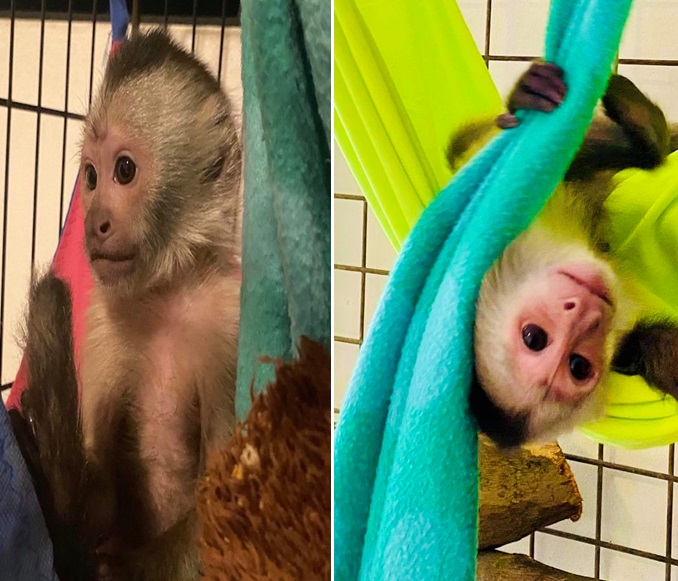
Maya is getting used to her blankets
If only the little monkey Jack was doing as well as Maya.
We knew that he had been totally traumatized by the loss of his mother and that he would need a lot of tender loving care and nurturing if he was going to have a chance of being a healthy baby. It was not known how long he had been with the native family but it must have been more than two days. As I began to talk more to them about his emotions and how important the role they play in a monkey’s life (especially a capuchin monkey), they began to understand that in Jack’s case he needed most to bond with one of them so that he might begin to have his own will to live. He needed to feel that he had a mom again. So this was what prompted them to allow one person to take over as the primary caregiver of Jack. The bonding began to happen instantly and the little monkey knew he had just what he needed. By making this change it proved to be the very best medicine of all for him. He was now able to become a much happier little boy.
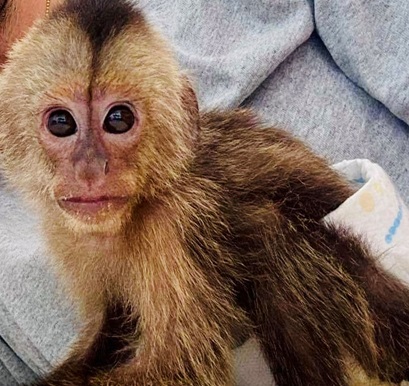
Jack still not doing well with his milk
Although Jack was drinking his formula, he was still remaining weak and not able to walk around like he should. It became apparent that he was not processing his formula correctly, and that this was the problem that was causing him to not gain weight and have his proper strength. He had become lactose intolerant to his formula. There were several other types of formula that did not contain milk, but after much consideration it turned out that the next thing to try would be to see if he would drink goats milk. Everyone was so relieved when Jack started drinking and processing the goats milk instead of the formula.
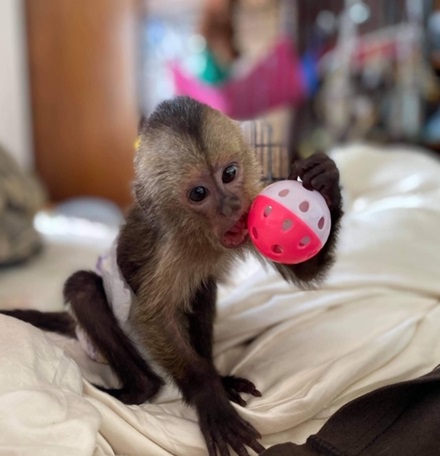
Jack finally beginning to feel better with his new goats milk
Jack was still very thin and fragile, but they were finally settled into a rather normal state of having the two capuchin monkeys in their lives. Maya had been very helpful to Jack during his early days of coming to them, because he could hear her voice and calls in the distance. It finally became the time for them to be brought into the same room where they both were able to see and talk to each other. The enrichment was wonderful for both monkeys and this became a new thing for the two monkeys to look forward to having every day. Jack was still not thriving but things were starting to settle into a new normal.
Since the two monkeys were now able to spend monkey time together in the same room with the fresh air and sunshine coming in through the wide opened windows, they decided to begin allowing Jack to be left in the room with only Maya for company. It took a few days for him to stop crying for them, but finally he was able to settle down and enjoy his exercise cage and his private time with Maya.
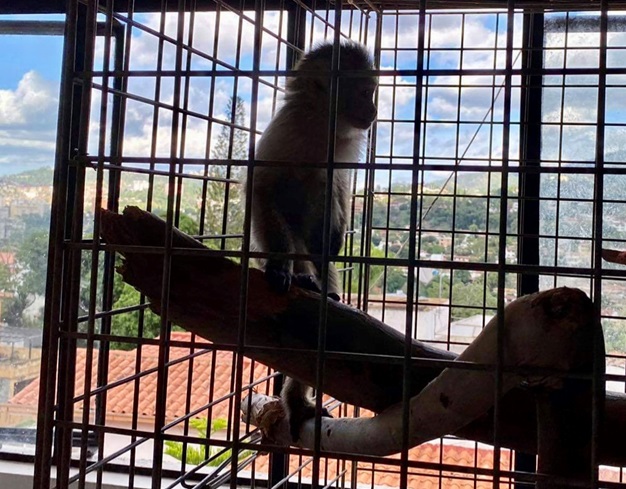
This was Maya’s enclosure with the air flowing through the open windows.
Maya was still afraid to be handled by the humans but she was becoming a well adjusted captive monkey and was a great temporary monkey sitter for Jack when he needed to have special monkey time in the room with her. Things were starting to begin to settle into a comfortable state of having the two monkeys in their lives. None of us were ready for Jack to suddenly develop having terrible seizures. How could this possibly be happening to Jack, just as he was beginning to gain strength and grounding in his new life? There was not any rhyme or reason as to why or when he was having a seizure, but each time he had one it was taking him longer to recover. He would have the seizure and then quickly become disorientated and then begin to spit up his food and not be able to return to his normal state for many hours after he had one. It was decided that they were going to need to take him to an experienced exotic veterinarian.
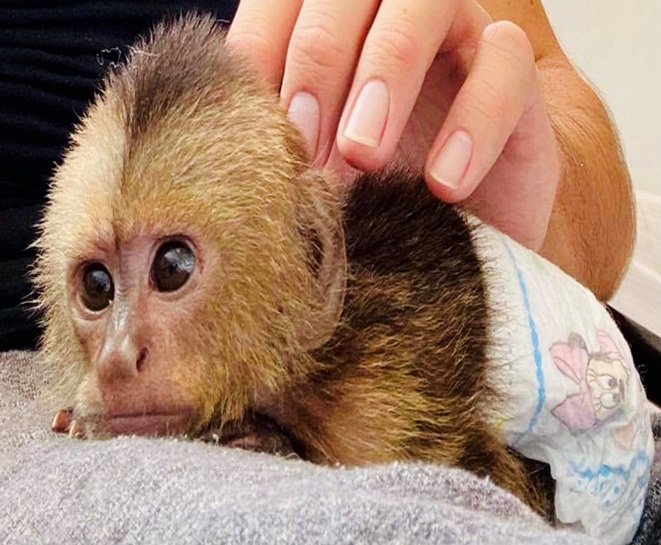
This is a photo of Jack after one of his first seizures.
While Jack was there at his appointment. the veterinarian decided to look into his eyes and then into his ears and to their surprise they found what they thought might be causing the entire seizure problem. The little guy had a very infected ear. The proper medicine and dosage was decided upon for his age and weight, and then his caregivers took him home with great hope for Jack in their hearts.
When they started the medicine with Jack, they began to notice within just a few doses that he was beginning to show signs of getting better with his happy energy finally beginning to return. We were all so pleased with his miraculous recovery. He was finally beginning to gain his health and mobility and even a new zest for life. We were all so thankful that the medicine was working and the seizures completely stopped occurring.
Since things were normalizing for my new friends in South America with Jack and Maya, we were not needing to be in contact with each other during the next few weeks and I was settling into that magical feeling that I get when I feel that I might have truly been helpful.

Jack is feeling better in this photo.
Very soon after the calls and messages with the family from South America had ended, I received a call to help a good friend from Facebook with her monkey who needed to be started on insulin. I was a little nervous with doing this over the phone but since I had actually met her and her monkeys, I knew that I was once again needed to be helpful. During this period of time she only had phone access to her trained exotic veterinarian. He was only talking to his clients over the phone and it was apparent that he would be able to write prescriptions for the things that we would need, but it also became apparent that his experience was limited in controlling diabetes in monkeys. Her little girl monkey’s glucose was dangerously high, and she was also testing extremely high for ketones. The oral medicine that she had been on was no longer able to control these types of high readings. My friend’s monkey needed to be started on insulin immediately.
As my friend and I were working together to get control of her precious monkey’s uncontrolled diabetes, I started thinking very heavily about my new friends from South America and I knew that I needed to connect with them once again to hear how they were doing with Maya and Jack. We were doing very well with our special little girl monkey going on insulin so I decided to message them.
The first returned message from my friends in South America actually took my breath away. It read, “Oh, Mary Lynn, I am crying as I am having to type these words to you. Please forgive me as I try to find the right words to type through my tears.” I quickly wrote back, “Whatever has happened we will get through this, you know how I believe in miracles.” I was very concerned as I anticipated the message that they were struggling to type out to me. I waited on pins and needles for them to type out what had happened in their life that was so devastating. The typing sign finally ended and the long message came up on Messenger and I quickly began reading it. After the first few sentences I began to cry.
Jack had been doing so much better since he had been on the antibiotics for the ear infection that they had discovered several week ago. He was finally healing from his ear infection and he had so much more energy that he had been playing and running on the bed. He ran too fast and turned too quickly which made him land with the back of his head hitting on the hard tile floor. He became instantly unconscious and then began to have a terrible seizure. As the seizure was ending he was pale, cold and his body became rigid and the caregiver thought he was dying. As he was coming out of this terrible state it took him many hours to begin to recover. He would try to get up and walk but he would quickly fall over and it was also apparent that he was unable to see during this time. It was really touch and go during this time as they were waiting to see if the little boy was going to survive. They had already called the exotic veterinarian as soon as they could and made the most peaceful decision which was to go ahead and sedate Jack in order to x-ray his head and do a blood test. They knew that they needed to be very aggressive with his care if they were going to save him.
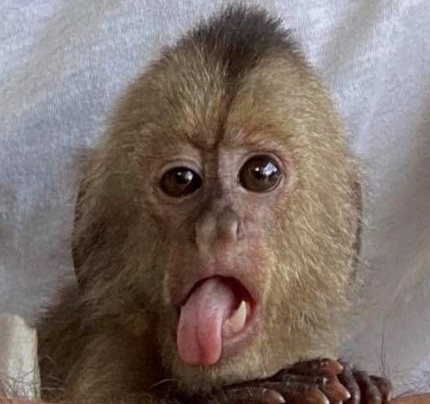
This photo was taken after Jack was starting to feel better after having his accident, being unconscious and having his severe seizure.
They had many unanswered questions. Could the fall have started the seizures to begin again? Could he have a serious underlying condition like encephalitis or some other thing going on? Had he injured his skull when he had fallen? All of these things needed to be addressed so chances had to be taken with his life in order to find these answers.
As it turned out, they did not have to sedate Jack to do the tests but by not doing this he had become very upset and he was now not feeling safe with his primary monkey caregiver. The emotional trauma that he had been through was not helping him at this time because he was still suffering from many seizures. At times he was so disoriented that he did not seem to know where he was or who he was with as he was trying to come out of each one of the seizures.

This was the exhausted little boy monkey and how deeply he rested after his tests at the exotic veterinarian’s office. He was so worn out from all of the days stresses and strains.
Finally, the results came in from Jack’s test. He definitely was not suffering from a serious virus or sickness but his ear was still not completely healed. The x-rays that the exotic veterinarian took appeared to show that he had not injured his skull during his accident. All of this was wonderful news but what would they do about the seizures? The vet wanted them to go and consult with a veterinarian who specialized in neurological problems. He suggested that they address Jack’s seizures with a special medicine used for them. He assured them that the first type of medicine they would try would have very few side effects on little Jack, and it might actually be able to help slow down or even correct the symptoms of the seizures. They felt that the medicine was definitely the best first step to help Jack at this time. The next type of medicine that they could try would be much stronger so all of us were praying that he would respond to the first type of medicine.
After they arrived home, they gave him his bottle and his first dose of the new seizure medicine. He was not himself at all after his trip to the veterinarian’s office. He was not trusting of anyone now that he was home and especially after the ordeal of trying to give him the new medicine. Their hearts were so heavy as they gathered around their dinning room table. Jack was fast asleep after his terrible ordeal of falling, the increased seizures, and the trauma he went through while they were doing the testing. Jack had lost faith in his primary caregiver completely after the ordeal after getting the medicine into him. They were all expressing their emotions in these moments. How were they going to be able to gain their precious little Jack’s trust again while having to give him the new medicine? In this emotional time, it was apparent that Jack’s primary caregiver was the family member who was suffering the most from this terrible eventful day.
As the weeks began to pass by the special little girl monkey was adjusting very well to her new life on insulin. I am so proud of that monkey’s ability to adjust so well to everything that her monkey mom had to change in her life. It was not a quick fix and one which added a lot of stress since they needed to test the little monkey’s blood sugar repeatedly throughout the day and night. There is not any book or pamphlet that reads, “How To Put Your Monkey On Insulin.” However, there are many monkey caregivers who are becoming good educators about how to feed your monkey a healthy diet and what are some of the danger signs to look for to know if you should check you monkey for diabetes.
After this journey for this little girl monkey and her monkey mom, I am happy to announce there is one more person out there that will pass the gifts that she has learned and experienced along to someone else because she now has her beloved monkey staying healthy and happy on her diet change and daily insulin injections. This illness is a very hard illness to manage in humans and is even harder to manage in monkeys.
Once again, I am very thankful for the opportunity to be truly helpful to another monkey family that needed help, I love the missions with the monkeys that I have.
Jack, the little wild-caught needy monkey’s health started to improve as the antibiotics finally healed the ear and eye infection. The seizure medication finally became easier to give to him by his caregiver. His strength and energy began to increase within a few weeks after his terrible accident.

Jack’s eyes began to clear and become brighter as the medicine began to do the healing work for him.
At the present time, Jack is still having seizures but they last a short period of time, and they do not seem to slow Jack down. He has had some issues develop with his behavior towards the beautiful Miss Maya. He loves to pick on her when the two of them are together playing in their huge exercise enclosure that has been build for them. He does not like to share the food that is put in several places throughout the enclosure and he loves to slip up behind her and pull her tail.
To me he acts just like a spoiled little brat baby brother. He knows he is special and greatly loved by everyone that meets him. He is handicapped with one side of his body not as strong as the other one but Maya is grateful for this. She knows that this will keep things evened out between them as he grows up.
We hope you enjoy the special photos of these “little monkey stars” of our story.
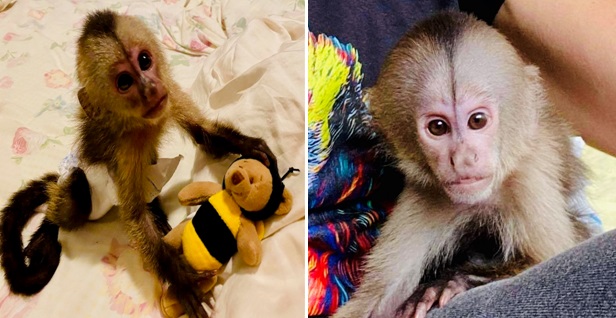
Left: Jack when a first came home. Right: Jack happy and healthy now
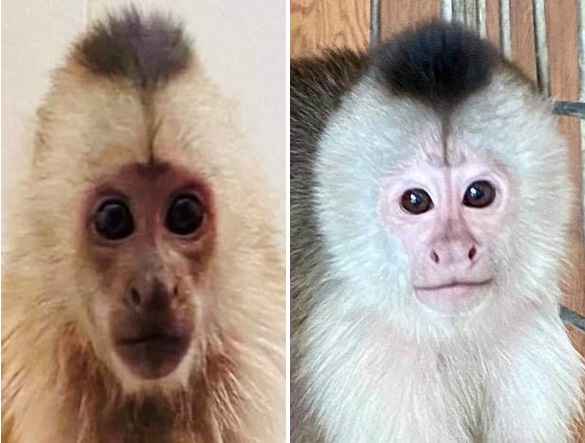
Left: Maya when she first arrived. Right: the beautiful Maya now
We hope you enjoyed reading about our experience with this special monkey family from South America. Because of Jack’s issue with taking his medicine like many of the other monkeys who become ill throughout the year, we will be doing our next post about training procedures that can be started for them to learn before a sickness begins so please stop by and visit us again here at the Primate Care site.
PS. I wish to thank the family from South America for allowing me to share their very special story. They were brave in their care for these two monkeys, especially where Jack’s health was concerned. I am not sure if I was able to help much, but I do know when traumatic times with my monkeys are occurring, that it means the world to me to have my wonderful network of loving souls around me.
When I think about living in a country where wild monkeys are out in the countrysides of towns; I certainly allow my imagination to run wild. If I were living in that part of the world, I know I would wish to be involved in loving and caring for the many monkeys who would need this type of support. I am excited to see how this loving family will choose to share their love for the primates in the future.
I would also like to say ‘Thank You’ to my friend who now has an insulin dependent monkey. Working with my friend to do this was an awesome experience for me. Someone very special had passed how to do this to me when my seven year old monkey, had to go on insulin twenty years ago.
As we close this post, we sincerely wish for you and your families to please stay healthy and remember… Choose To Be The Very Best Monkey Caregiver That You Can Be.
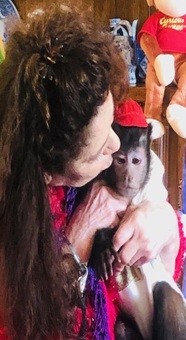
Mary Lynn and Silly Willy
Thank you for visiting us here at Primate Care. We are committed to bringing good information for you to think about and share with your family, friends, and other monkey caregivers. Our next post will be called “Sickness Training.” We will be talking about things that can help your monkey survive a possible sickness in their future.
Written by Mary Lynn Campbell author of “Living With Monkeys”